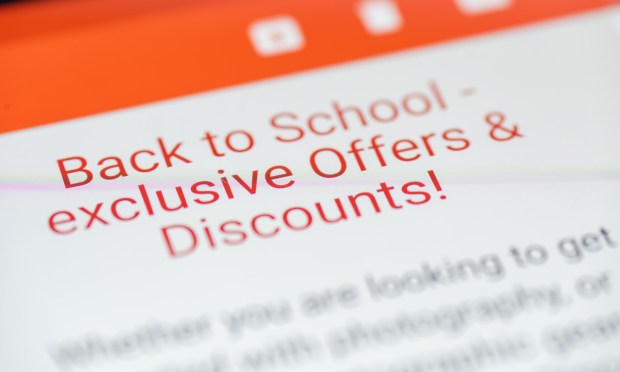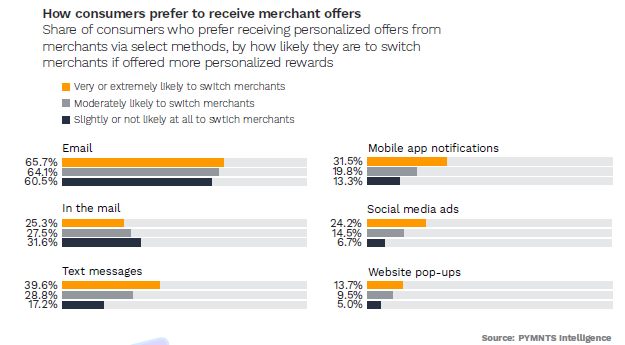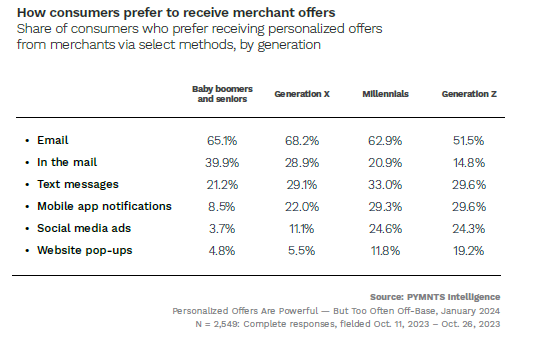Two-Thirds of Consumers Prefer to Receive Personalized Offers via Email

Personalized offers have become a driving force in consumer behavior in today’s fast-evolving market landscape, reshaping shopping habits and influencing brand loyalty.
The ability to tailor offers to individual preferences has motivated consumers to break their usual habits and explore new merchants, fostering an environment where brand loyalty is no longer solely dependent on familiarity but rather on the tailored experiences and incentives offered.
According to findings detailed in a recent PYMNTS Intelligence study, this trend has been largely driven by millennials, with 41% expressing a likelihood to switch to merchants offering more personalized deals.
Meanwhile, Generations Z and X follow closely behind at 34% and 26%, respectively. In contrast, baby boomers and seniors show less inclination to change merchants based on personalized offers, though about 1 in 8 from these groups would still consider switching.

Examining the data further shows that the ease of acting on a personalized offer significantly influences consumers’ decisions to switch merchants, emphasizing the importance of the delivery method. What constitutes “ease” varies among generations, with consumers leaning toward platforms that align with their respective age groups.
In terms of how consumers prefer to receive merchant offers, while email remains the preferred channel for two-thirds of consumers to receive offers, a closer analysis reveals a more nuanced perspective: younger consumers favor digital formats like texts, apps, social media, and pop-ups, while older generations lean toward receiving offers via traditional mail or email.
Specifically, over 60% of both baby boomers and Generation X consumers show a distinct inclination toward receiving these tailored offers through email, while this method is favored by only 51% of Generation Z consumers.
In contrast, mobile app notifications emerge as a preferred medium for nearly 30% of millennials and Generation Z, compared to a smaller percentage (22%) among Generation X and less than 10% among baby boomers. A parallel trend is observed in social media ads, with about one-quarter of millennials favoring this delivery method, while only 11% of Generation X and a mere 4% of boomers show a similar preference.
These preferences highlight the necessity for merchants to tailor their delivery methods to suit their audience, ensuring accessibility and appeal across different age groups.

However, merchants shouldn’t inundate customers with offers through multiple channels like phone, mail and email, the study notes. On average, consumers prefer to receive offers through about 1.7 channels, indicating the importance of varying offers but suggesting that an excessive number of channels might not yield proportional benefits for merchants.
Additionally, while monetary offers remain the most influential purchase incentive for over half of consumers, the survey found that well-personalized, non-monetary offers can build customer loyalty without solely relying on discounts.
For instance, exclusive access to new products or personalized recommendations are appealing non-monetary incentives, although they hold less sway compared to savings-based incentives. Discount and promotion offers, as well as free shipping, are also highly valued by consumers.
In conclusion, successful personalization can yield significant benefits for merchants who adopt a comprehensive approach. This involves integrating data management, customer segmentation, and multichannel strategies to cater to diverse consumer groups.
By improving the accuracy of personalized offers and using data-driven approaches, merchants can tap into prospective customer bases, drive sales, and foster long-term loyalty in a competitive market.

